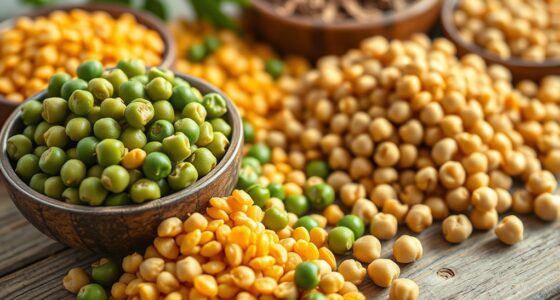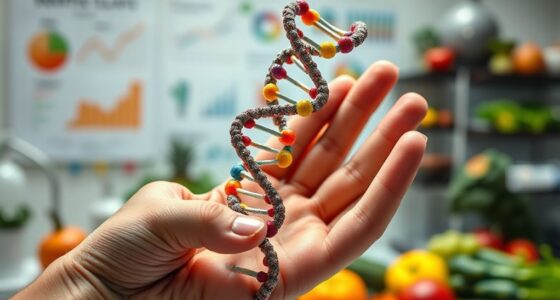Understanding the differences between soluble and insoluble fiber helps you improve your digestion and heart health. Soluble fiber dissolves in water, forming a gel that slows digestion, stabilizes blood sugar, and lowers cholesterol. Insoluble fiber adds bulk to your stool, speeding up transit and preventing constipation. You can find soluble fiber in oats, beans, and fruits, while whole grains and vegetables are rich in insoluble fiber. Continue exploring to learn how to balance both for ideal wellness.
Key Takeaways
- Soluble fiber dissolves in water, forming a gel that slows digestion and lowers cholesterol, found in oats, beans, and fruits.
- Insoluble fiber adds bulk to stool, speeds transit, and prevents constipation, present in whole grains, nuts, and vegetables.
- Soluble fiber supports blood sugar regulation and heart health through fat and cholesterol binding.
- Insoluble fiber promotes gastrointestinal health by increasing stool bulk and encouraging regular bowel movements.
- Incorporate both fiber types via diverse foods like oats, legumes, whole grains, and vegetables for balanced digestive benefits.
What Is Soluble Fiber and How Does It Work?

Soluble fiber dissolves in water, forming a gel-like substance in your digestive system. This gel slows down digestion and helps regulate blood sugar levels, offering key soluble fiber benefits. When you consume foods rich in soluble fiber, it binds with fats and cholesterol, assisting in lowering bad cholesterol and supporting heart health. During soluble fiber digestion, bacteria in your gut ferment it, producing short-chain fatty acids that nourish your colon. This process also promotes a feeling of fullness, which can aid in weight management. Because soluble fiber dissolves easily, it helps stabilize your blood glucose levels after meals. Overall, incorporating soluble fiber into your diet boosts digestion, improves gut health, and provides steady energy release throughout the day.
What Is Insoluble Fiber and Its Role in Digestion
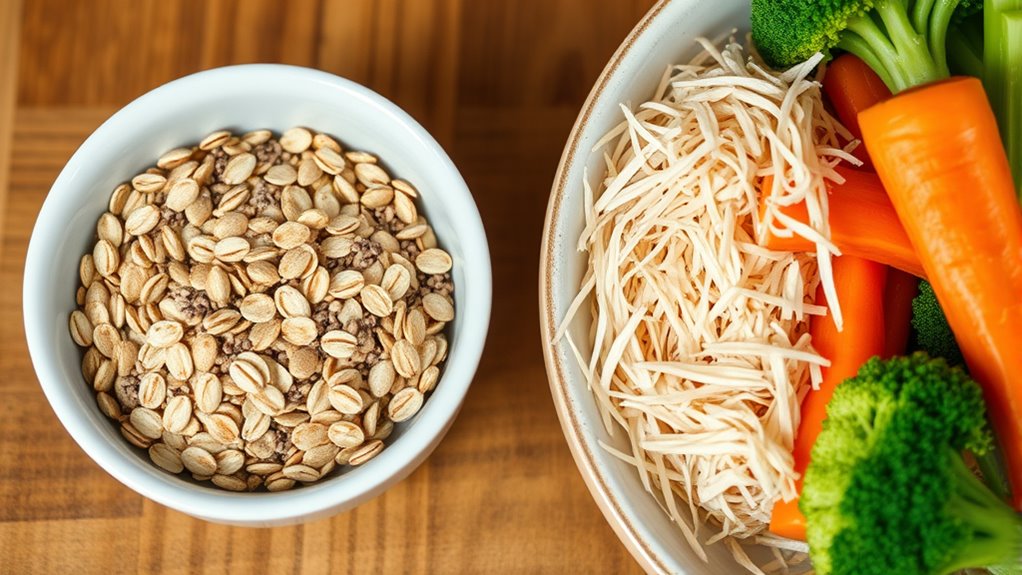
Insoluble fiber plays a crucial role in maintaining healthy digestion by adding bulk to your stool and speeding up its passage through your digestive tract. This type of fiber’s impact on gut health is significant because it helps prevent constipation and promotes regular bowel movements. As insoluble fiber resists digestion, it stays intact as it moves through your system, increasing stool bulk and encouraging quicker transit. Incorporating insoluble fiber into your diet supports the natural cleansing of your digestive system, maintaining overall gut health. Understanding the role of fiber can help you make better dietary choices for optimal digestive health. Additionally, insoluble fiber’s ability to increase stool bulk contributes to overall gastrointestinal well-being.
Common Food Sources Rich in Soluble Fiber
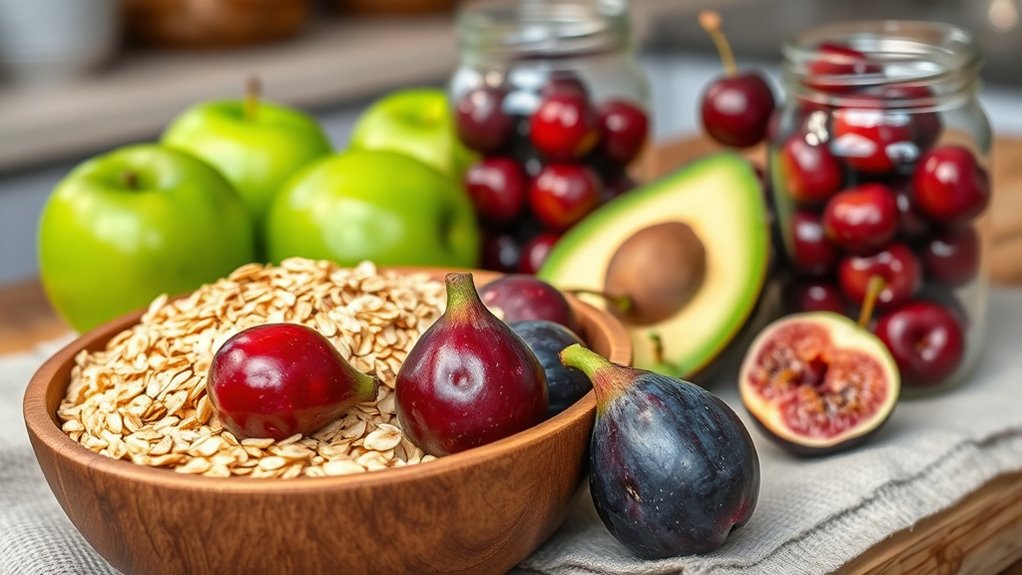
Are you looking to boost your intake of dietary fiber? Foods rich in soluble fiber are a great way to do that. You can explore superfood options like oats, barley, and legumes such as beans and lentils. These foods help lower cholesterol and stabilize blood sugar levels. If you prefer more convenience, fiber supplement options like psyllium husk or glucomannan are effective and easy to incorporate into your routine. Incorporating these sources into your diet supports heart health and digestion. Aim to include at least one of these in your daily meals or snacks. Whether through natural foods or supplements, increasing soluble fiber intake can make a noticeable difference in your overall wellness.
Foods High in Insoluble Fiber and Their Benefits

Want to improve your digestive health and prevent constipation? Foods high in insoluble fiber are your best choice. These foods add bulk to your stool, helping it move smoothly through your digestive system. Incorporate fiber-rich snacks like whole wheat crackers, nuts, and raw vegetables to boost your intake. Insoluble fiber benefits include faster digestion, reduced risk of hemorrhoids, and better bowel regularity. Whole grains such as brown rice, wheat bran, and oats are excellent sources. Seeds like flaxseed and sunflower seeds also pack a punch. Including these foods regularly can support your gut health and keep things moving efficiently. Automation in business technologies are being integrated into food production processes to improve efficiency. Remember, a diet rich in insoluble fiber can make a noticeable difference in your overall digestive comfort and health.
How to Incorporate Both Fiber Types Into Your Diet

To effectively incorporate both soluble and insoluble fiber into your diet, start by including a variety of fiber-rich foods at each meal. This guarantees you get a balanced mix of fiber types for best health.
- Add oats, beans, or fruits like apples and berries for soluble fiber.
- Include whole grains, nuts, and vegetables such as carrots and broccoli for insoluble fiber.
- If you’re struggling to meet fiber intake guidelines, consider fiber supplement options like powders or capsules, but prioritize whole foods first.
Balancing fiber sources supports digestion and overall well-being. Remember, gradually increase your fiber intake to avoid discomfort and stay well-hydrated. Combining food sources with supplements can help you meet your daily fiber needs effectively.
Tips for Achieving a Balanced Fiber Intake
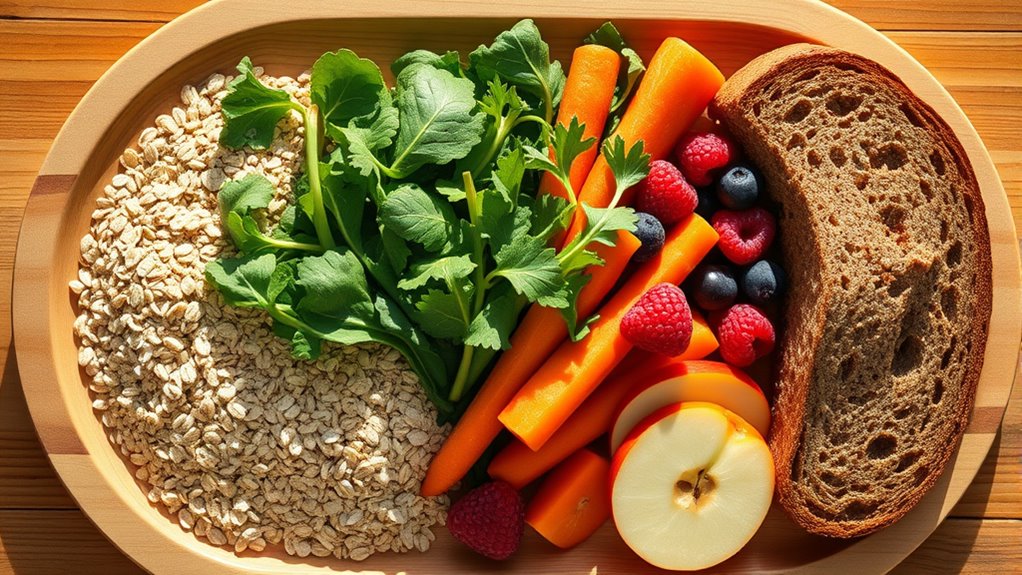
Achieving a balanced fiber intake requires mindful planning and consistent effort. Start by following dietary guidelines, which recommend a mix of soluble and insoluble fibers from whole foods like fruits, vegetables, grains, and legumes. Incorporate a variety of fiber-rich foods throughout your day to ensure diversity and meet your daily goals. If you’re struggling to reach your fiber target through diet alone, fiber supplementation can help fill the gap, but consult a healthcare professional first. Gradually increase your fiber intake to prevent digestive discomfort. Drinking plenty of water supports fiber’s benefits and helps prevent constipation. Additionally, understanding the different functions of soluble and insoluble fibers can help tailor your intake to support overall wellness. Recognizing the sources of fiber in your diet can further optimize your nutrition plan. Being aware of your fiber intake can improve digestion and overall health. Regularly reviewing your diet and adjusting sources guarantees you maintain a healthy, balanced fiber intake that supports overall wellness.
Frequently Asked Questions
How Does Fiber Intake Affect Long-Term Health Risks?
You might notice that increasing your fiber intake reduces long-term health risks, like heart disease and diabetes. Fiber supplement benefits include better digestion and lowered cholesterol. Plus, fiber and weight management go hand in hand, helping you feel full longer and preventing overeating. Consistently eating high-fiber foods or supplements can improve your overall health, making it easier to maintain a healthy weight and reduce future health issues.
Can Fiber Types Influence Blood Sugar Control Differently?
Fear not, fiber’s fascinating functions fuel your blood sugar balance. Soluble fiber, slowing sugar spikes, stabilizes your bloodstream, while insoluble fiber, adding bulk, keeps things moving smoothly. Their distinct roles create a dynamic duo, directly impacting your fiber impact on blood sugar. By incorporating both types into your diet, you can appreciably strengthen your body’s ability to manage glucose, promoting healthier habits and happier health.
Are There Any Specific Populations Needing More of One Fiber Type?
You might wonder if certain target populations need more of a specific fiber type. Yes, some groups, like those with diabetes or gastrointestinal issues, benefit from increased soluble fiber to help manage blood sugar or improve digestion. Pregnant women and older adults may also need tailored fiber recommendations for ideal health. It’s best to follow personalized fiber guidelines to support your unique health needs and improve overall well-being.
What Are the Potential Side Effects of Excessive Fiber Consumption?
When you push the limits, issues can crop up. Excessive fiber intake may cause gastrointestinal issues like bloating, gas, and constipation. It can also interfere with nutrient absorption, leading to deficiencies. To stay on the safe side, increase your fiber intake gradually and stay well-hydrated. Too much of a good thing can backfire, so moderation is key to avoiding uncomfortable side effects.
How Does Preparation Affect Fiber Content in Foods?
Preparation markedly impacts the fiber content in foods. Food processing and cooking methods can alter fiber levels; for instance, peeling, milling, or boiling may reduce fiber, while steaming or eating foods raw preserves it. You should be mindful of how different techniques affect fiber retention, as over-processing can diminish nutritional benefits. To maximize fiber intake, opt for minimal processing and gentle cooking methods whenever possible, keeping your diet rich in fiber.
Conclusion
By including both soluble and insoluble fiber in your diet, you support digestion, boost heart health, and maintain steady energy levels. You nourish your gut, regulate your bowels, and feel more energized. You enjoy a variety of delicious foods, embrace healthy habits, and create a balanced lifestyle. Together, soluble and insoluble fibers work harmoniously to keep you healthy, vibrant, and feeling your best every day.


